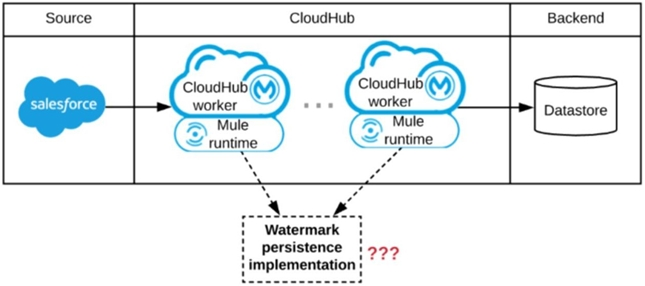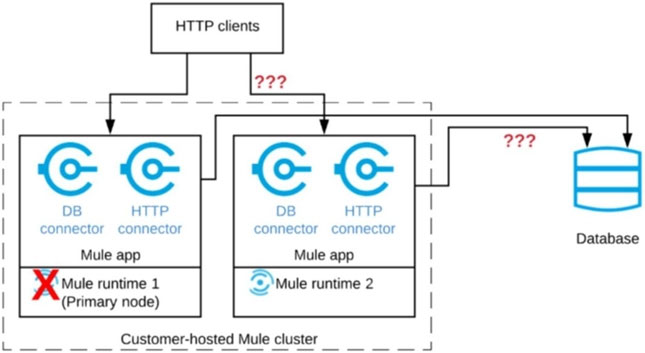MuleSoft MCIA - Level 1 Exam Practice Questions (P. 2)
- Full Access (101 questions)
- Six months of Premium Access
- Access to one million comments
- Seamless ChatGPT Integration
- Ability to download PDF files
- Anki Flashcard files for revision
- No Captcha & No AdSense
- Advanced Exam Configuration
Question #6
Refer to the exhibit. A Mule application is being designed to be deployed to several CloudHub workers. The Mule application's integration logic is to replicate changed Accounts from Salesforce to a backend system every 5 minutes.
A watermark will be used to only retrieve those Salesforce Accounts that have been modified since the last time the integration logic ran.
What is the most appropriate way to implement persistence for the watermark in order to support the required data replication integration logic?

A watermark will be used to only retrieve those Salesforce Accounts that have been modified since the last time the integration logic ran.
What is the most appropriate way to implement persistence for the watermark in order to support the required data replication integration logic?

- APersistent Object StoreMost Voted
- BPersistent Cache Scope
- CPersistent Anypoint MQ Queue
- DPersistent VM Queue
Correct Answer:
A
A
send
light_mode
delete
Question #7
Refer to the exhibit. A shopping cart checkout process consists of a web store backend sending a sequence of API invocations to an Experience API, which in turn invokes a Process API. All API invocations are over HTTPS POST. The Java web store backend executes in a Java EE application server, while all API implementations are Mule applications executing in a customer-hosted Mule runtime.
End-to-end correlation of all HTTP requests and responses belonging to each individual checkout instance is required. This is to be done through a common correlation ID, so that all log entries written by the web store backend, Experience API implementation, and Process API implementation include the same correlation ID for all requests and responses belonging to the same checkout instance.
What is the most efficient way (using the least amount of custom coding or configuration) for the web store backend and the implementations of the Experience
API and Process API to participate in end-to-end correlation of the API invocations for each checkout instance?

End-to-end correlation of all HTTP requests and responses belonging to each individual checkout instance is required. This is to be done through a common correlation ID, so that all log entries written by the web store backend, Experience API implementation, and Process API implementation include the same correlation ID for all requests and responses belonging to the same checkout instance.
What is the most efficient way (using the least amount of custom coding or configuration) for the web store backend and the implementations of the Experience
API and Process API to participate in end-to-end correlation of the API invocations for each checkout instance?

- AThe Experience API implementation generates a correlation ID for each incoming HTTP request and passes it to the web store backend in the HTTP response, which includes it in all subsequent API invocations to the Experience API The Experience API implementation must be coded to also propagate the correlation ID to the Process API in a suitable HTTP request header

- BThe web store backend generates a new correlation ID value at the start of checkout and sets it on the X-CORRELATION-ID HTTP request header in each API invocation belonging to that checkout No special code or configuration is included in the Experience API and Process API implementations to generate and manage the correlation ID
 Most Voted
Most Voted - CThe web store backend, being a Java EE application, automatically makes use of the thread-local correlation ID generated by the Java EE application server and automatically transmits that to the Experience API using HTTP-standard headers No special code or configuration is included in the web store backend, Experience API, and Process API implementations to generate and manage the correlation ID

- DThe web store backend sends a correlation ID value in the HTTP request body in the way required by the Experience API The Experience API and Process API implementations must be coded to receive the custom correlation ID in the HTTP requests and propagate it in suitable HTTP request headers

Correct Answer:
B
B
send
light_mode
delete
Question #8
Mule application A receives a request Anypoint MQ message REQU with a payload containing a variable-length list of request objects. Application A uses the For
Each scope to split the list into individual objects and sends each object as a message to an Anypoint MQ queue.
Service S listens on that queue, processes each message independently of all other messages, and sends a response message to a response queue.
Application A listens on that response queue and must in turn create and publish a response Anypoint MQ message RESP with a payload containing the list of responses sent by service S in the same order as the request objects originally sent in REQU.
Assume successful response messages are returned by service S for all request messages.
What is required so that application A can ensure that the length and order of the list of objects in RESP and REQU match, while at the same time maximizing message throughput?
Each scope to split the list into individual objects and sends each object as a message to an Anypoint MQ queue.
Service S listens on that queue, processes each message independently of all other messages, and sends a response message to a response queue.
Application A listens on that response queue and must in turn create and publish a response Anypoint MQ message RESP with a payload containing the list of responses sent by service S in the same order as the request objects originally sent in REQU.
Assume successful response messages are returned by service S for all request messages.
What is required so that application A can ensure that the length and order of the list of objects in RESP and REQU match, while at the same time maximizing message throughput?
- APerform all communication involving service S synchronously from within the For Each scope, so objects in RESP are in the exact same order as request objects in REQU
- BUse a Scatter-Gather within the For Each scope to ensure response message order Configure the Scatter-Gather with a persistent object store
- CKeep track of the list length and all object indices in REQU, both in the For Each scope and in all communication involving service. Use persistent storage when creating RESPMost Voted
- DUse an Async scope within the For Each scope and collect response messages in a second For Each scope in the order in which they arrive, then send RESP using this list of responses
Correct Answer:
B
B
send
light_mode
delete
Question #9
Refer to the exhibit. A Mule application is deployed to a cluster of two customer-hosted Mule runtimes. The Mule application has a flow that polls a database and another flow with an HTTP Listener.
HTTP clients send HTTP requests directly to individual cluster nodes.
What happens to database polling and HTTP request handling in the time after the primary (master) node of the cluster has failed, but before that node is restarted?

HTTP clients send HTTP requests directly to individual cluster nodes.
What happens to database polling and HTTP request handling in the time after the primary (master) node of the cluster has failed, but before that node is restarted?

- ADatabase polling stops All HTTP requests are rejected
- BDatabase polling stops All HTTP requests continue to be accepted
- CDatabase polling continues Only HTTP requests sent to the remaining node continue to be acceptedMost Voted
- DDatabase polling continues All HTTP requests continue to be accepted, but requests to the failed node incur increased latency
Correct Answer:
A
A
send
light_mode
delete
Question #10
What aspects of a CI/CD pipeline for Mule applications can be automated using MuleSoft-provided Maven plugins?
- AImport from API designer, compile, package, unit test, deploy, publish to Anypoint Exchange
- BCompile, package, unit test, validate unit test coverage, deployMost Voted
- CCompile, package, unit test, deploy, integration test
- DCompile, package, unit test, deploy, create associated API instances in API Manager
Correct Answer:
C
Reference:
http://workshop.tools.mulesoft.com/modules/module7_lab4#step-2-configure-the-mule-maven-plugin
C
Reference:
http://workshop.tools.mulesoft.com/modules/module7_lab4#step-2-configure-the-mule-maven-plugin
send
light_mode
delete
All Pages
